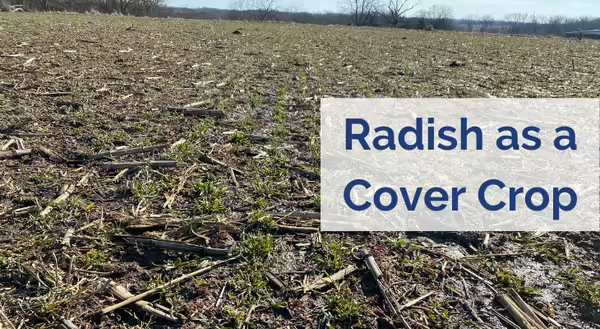
Ooooh that smell. Can’t you smell that smell (read to the tune of That Smell by Lynyrd Skynyrd). If you have been driving around the countryside recently, you might already know what I am talking about; however, for those of you that don’t, as the temperatures warm up, a foul smell may begin floating around select farmer’s fields. Some say it smells like a gas leak while others might give their vehicle companion a nasty look, but the true culprit is the radish.
The smell comes from the decomposition of the radish plant. Radishes are commonly used as a cover crop due to their ability to perform “bio-tillage”. Dependent on the date of establishment and other environmental factors, these plants can produce a taproot that can disturb soil up to 8” deep (sometimes deeper) which can potentially help break up compaction. They are also known to be excellent scavengers of excess nitrogen in the fall. In Illinois, radishes are often winter killed which cuts down on the need to terminate in the spring. Overall, cover crops can provide many benefits by preventing soil erosion, conserving soil moisture, protecting water quality, increasing soil organic matter, and so much more.
These radishes are often mixed with a grass species such as cereal rye which will overwinter and continue to grow in the spring. There are different types of radishes that can be utilized as a cover crop and include the oilseed, forage, and tillage radish. Cover crops can be seeded by drill after harvest, flown on with an airplane while the crop is still standing, or interseeded into the row while the crop is still standing with modified high clearance equipment such as a sprayer.
Radishes are just one of many options for cover crops that can be used. When it comes to determining what is the best option for personal use, it is important to know the cover crop’s specialty and how to best manage it. The Midwest Cover Crop Council provides a cover crop decision tool that can easily be used to determine what cover crops meet your needs and when to plant them. What’s even better is it being available for both row crops and vegetable crops as they can benefit our soils in both situations.
Good Growing Tip: Although radishes create this less than desirable smell as it decomposes, the smell typically only lasts about 3 to 5 days. Hopefully you will find that the benefits as a cover crop outweigh the negative of the smell.
Want to get notified when new Good Growing posts are available? SIGN UP HERE!